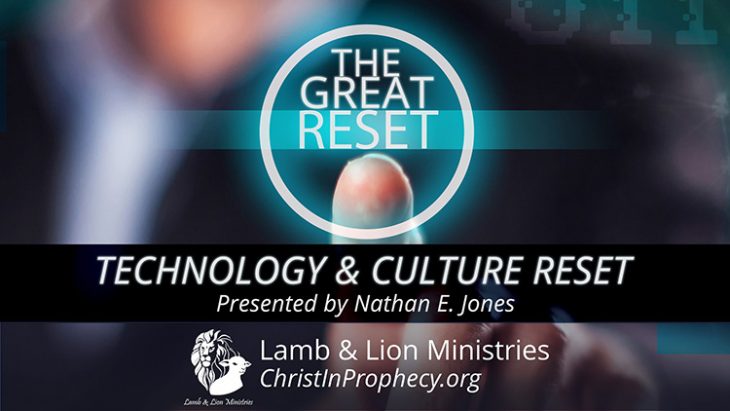The rapid rise of the Globalist agenda that’s bent on forming Satan’s prophesied one-world government is called “The Great Reset.” In these efforts, Satan has been using today’s technologies to unite the world under his new culture and ethos. In the first segment, we began by analyzing how drastically this modern-day tech culture is negatively affecting our vulnerable youth. Then we identified Satan’s five-step strategy in bringing about his one-world government. We will continue to examine the technological means by which Satan progresses his insidious agenda.
Category 3: Communications
The author of the book of Ecclesiastes once wisely noted that “a threefold cord is not quickly broken” (Ecclesiastes 4:12). So then, what’s better than one computer working alone? The answer is three, or three hundred, or three million, or even better three billion, devices all working together.
Hence, we come to our third vital category of technologies which comprise the smartphone — communications technologies. This category consolidates a virtually mind-numbing array of various technologies, encompassing everything including print and audio and video. Radios, transmitters, televisions, cell towers, satellites, cable, cameras, Wi-Fi, fiber optics, and the complicated infrastructure that connects all of these technologies into one massive network provide just the tip of the communications technologies iceberg.
The true genius came when all of these technologies began to be linked together some 60 years ago, initially as a weapon by the United States to combat the Cold War. We call it the Internet today, but this wonder of modern-day life was birthed as a means for scientists and researchers to communicate and share their computer data across vast distances in their efforts to combat the Communist world. As soon as the Soviet Union launched the world’s first manmade satellite named Sputnik into orbit on October 4, 1957, a spooked U.S. federal government quickly formed the National Aeronautics and Space Administration (NASA) and the Department of Defense’s Advanced Research Projects Agency (ARPA). These agencies would wage the Cold War by developing space-age technologies that would lead the world into the digital age.
Much like many today who are concerned that an EMP blast will destroy a nation’s electrical grid, military experts in the 1950s worried that a few missiles could take down the whole network of lines which make efficient long-distance communication possible. And so, in 1962, a scientist at ARPA by the name of J.C.R. Licklider proposed his solution of building a “galactic network” of computers that could talk to one another and enable government leaders to communicate even if the Soviets destroyed the telephone system.14 On October 29, 1969, two house-sized computers, one at the research lab at UCLA and the second at Stanford University, shared their first node-to-node message which read “LOGIN”. The Internet was born! Well, not quite yet. The ARPAnet was born!
By the end of 1969, the two computers linked together became four, and throughout the 1970s more and more military and research computers all around the world were identifying each other by Internet Protocol (IP) address and sharing their data. Then, in 1991, a Swiss computer programmer by the name of Tim Berners-Lee (not Al Gore) opened up the burgeoning connectivity to the general public over what he called the World Wide Web when he created the first web server (CERN HTTPd) and the very first website (http://info.cern.ch/). Now anyone with a personal computer could access the Web over browsers such as Mosaic, Netscape, Internet Explorer, Firefox, Chrome, and Safari. With such massive amounts of data being shared as millions of new computers were being connected to the Internet every day, search engines such as Google, AltaVista, AskJeeves, Yahoo, and later Bing mapped and indexed all of that data. A world of information was literally at anyone’s fingertips via their desktop or mobile device.
As of 2020, 4.54 billion of the 7.77 billion people in the world are connected by the Internet, and 4.18 billion of them utilize a mobile device.15 In the United States, 100% of 18- to 29-year-olds, 97% of 30- to 49-year-olds, 88% of 50- to 64-year-olds and 73% of 65-year-olds and older are Web “surfers.”16 The average Internet user spends 6.5 hours online every day generating 88,555 gigabytes of Internet traffic every second!17 The average smartphone user will spend an average of 3 hours 49 minutes each day on their devices, dedicating 90% of their time to downloading any of the 5+ million applications (Apps) from the leading App stores such as Google Play, Apple’s iTunes and Amazon.18
Truly, the Internet over smartphones has developed into today’s Tower of Babel. Language barriers are even becoming a thing of the past, as translation Apps such as Google Translate have been developed to turn one’s smartphone into a Star Trek-like universal translator.
The networks are getting faster and more robust, as fifth-generation (5G) technology is being implemented at record speed to keep up with the exabytes of data being shared. And, the Internet continues to expand into its third phase, seeking to encompass every device from your coffeemaker to your pacemaker to your car into the Internet of Things (IoT).
Alphabet, the parent company which owns Google, has risen to become a monopoly, channeling 92% of Web searches and 44% of all emails generated, and it now decides who sees what information.19 Cries of Internet censorship, especially against Christian and Conservative viewpoints, are on the rise. As television fiction writer J. Michael Straczynski quoted through one of his characters, “He who controls information controls the world.”20
Category 4: Ecommerce
Like most inventions, the Internet did not really take off until businesses began to realize there was money to be made and the end-users how they could more easily purchase stuff. The buying and selling of products and services had to move beyond the brick-and-mortar and into the electronic realm of online shopping. This now leads us to the fourth vital category of technologies which comprise the smartphone — ecommerce technologies.
Electronic commerce, or ecommerce, had its humble beginnings back in the 1970s with Electronic Data Interchanges and teleshopping. In 1979, Michael Aldrich in the United Kingdom connected a modified television via a telephone line to a real-time multi-user transaction processing computer and sold his invention as a business-to-business (B2B) solution.
Once the Internet opened up to the public in 1991, companies such as Book Stacks Unlimited (now Barnes & Noble), Amazon, Etsy, and eBay quickly became popular as the go-to online shopping experience. To further consumer confidence, as online shoppers worried about losing their financial data to the growing threat of hackers, Secure Socket Layers (SSL) was released in 1994 to secure Web browsers and protect users’ financial data. The new trust in online shopping swung the boom away from buildings to ecommerce websites. Many long-lived shopping chains, such as Sears and JCPenney, too slow to adapt to an online model, quickly found themselves facing bankruptcy. A seismic shift in commerce transformed the world in just a few short years.
With the rise of ecommerce came the rise of online banking, and soon cash gave way to electronic funds and new currencies such as the Bitcoin. Global ecommerce companies like PayPal, which began its services in 1998, and Authorize.Net and others provide transaction services across all economies and currencies to billions of people worldwide.21 As entirely cashless societies are being considered, with Sweden leading the way with plans to go all-digital in March of 2023, concerns are growing about how much power banks now have over people’s finances. For every transaction, banks and transaction services get a cut, and so have grown tremendously wealthy and influential. Increasingly, stories are emerging of banks and transaction entities such as PayPal cutting people off from their finances over ideological disagreements. Once a society goes cashless, a person can easily be separated from their assets by the order of a government or bank with the mere push of a button.
Online shopping has increasingly gone mobile. In 2010, payments platform Square allowed small businesses to accept debit and credit cards over mobile devices, so that by 2017, Square’s gross payment volume was $17.9 billion.22 Since then, more than a third of U.S. e-commerce sales have been made over smartphones. The top 100 online marketplaces sold $203 trillion in goods in 2019.23 An expected 47% of all shopping will be done over a mobile device in 2020. And, just like the computer and Internet tech giants, online shopping giants such as Amazon, which alone sold over $275 billion in goods in 2019, have risen to an almost monopoly status with no entity able to stop them from censoring merchants who depend on Amazon as practically their only marketplace.
In the sixth and final segment in this series about the Great Reset, we will end by examining the technological means by which Satan progresses his insidious agenda, specifically the technologies that involve entertainment and security. Finally, we’ll tie all of this series together by identifying just what the prophesied end times culture will look like.
References
14. History.com Editors, “The Invention of the Internet,” History, (October 28, 2019), https://www.history.com/topics/inventions/invention-of-the-internet.
15. “Internet Stats & Facts (2020)” (accessed May 2020), https://hostingfacts.com/internet-facts-stats/.
16. Ibid.
17. Ibid.
18. Ibid.
19. Laura Nichols, “Poll: Gmail Dominates Email Use Among Millennials, Gen X,” Morning Consultant, (June 21, 2017), https://morningconsult.com/2017/06/21/poll-gmail-dominates-email-use/.
20. “Quotes” (accessed May 2020), https://www.quotes.net/mquote/679654.
21. “The History Of Ecommerce: How Did It All Begin?,” Meva, (October 26, 2011), https://www.miva.com/blog/the-history-of-ecommerce-how-did-it-all-begin/.
22. Ibid.
23. “Internet Stats & Facts (2020).”







